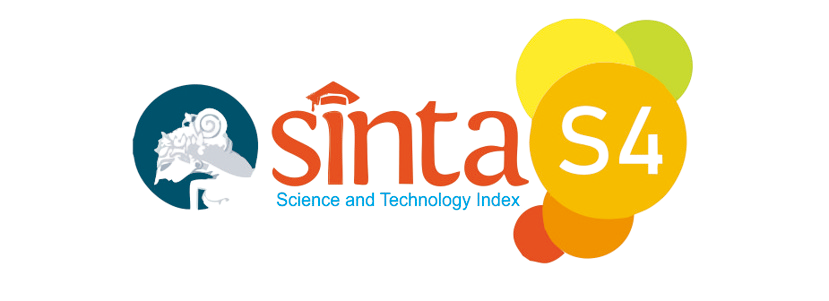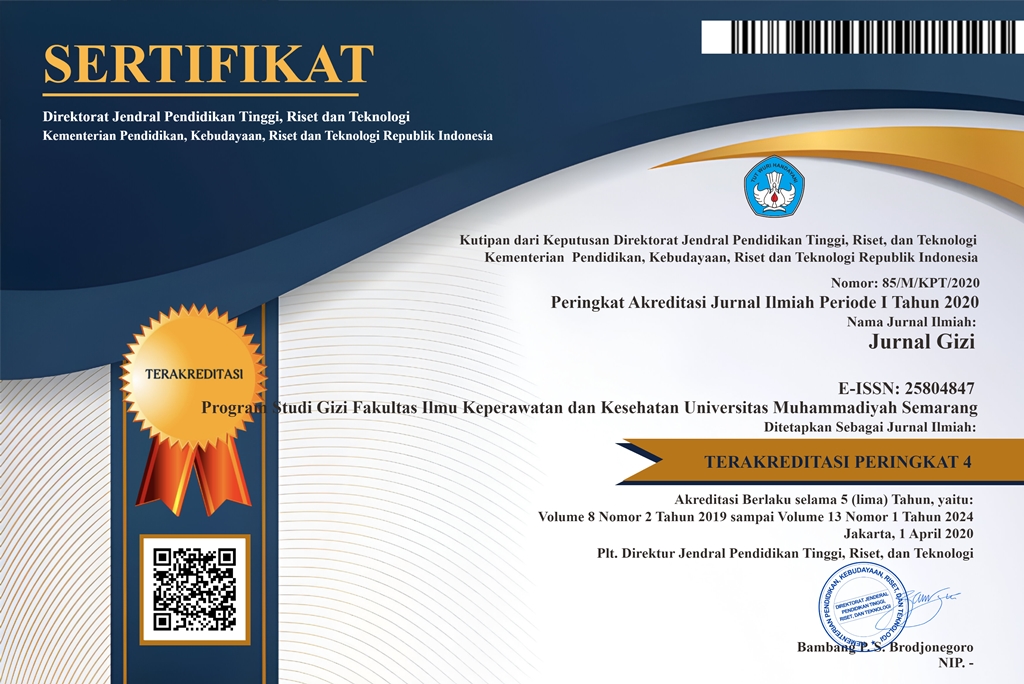Author Guidelines
Online Submission Guidelines
Manuscripts must be sent online to the online portal of Jurnal Gizi on page https://jurnal.unimus.ac.id/index.php/jgizi/index
Steps for submitting Manuscripts
· The author registers as an author (checking the author role) on the "Register" section on the page https://jurnal.unimus.ac.id/index.php/jgizi/user/register
· After the author logs in as an Author, click "New Submission".
· The stages of article submission consist of 5 stages:
1. In the Start section, check all checklists, then click save & continue.
2. In the Upload Submission section, please upload the article manuscript file in MS Word in this section. After that, click save & continue.
3. In the Enter Metadata section, enter the data of all authors and affiliates. If the author is more than one person, please click "add author", then fill in the author's data like the first author, and so on. Next, fill in the title, abstract, keywords, research methods, and bibliography in each of the available columns.
4. In the Upload Supplementary Files section, it is permissible to upload supporting files or cover letters or other documents.
5. In the Confirmation section, please click "Finish Submission" if all data is correct.
General Instructions
1. Articles are formatted according to the writing pattern of the scientific journal. Writing articles follow the rules set out in Publication Manual of the American Psychological Association (APA), Sixth Edition. Please use Mendeley or Zotero reference management software, turn on “the American Psychological Association (APA), Sixth Edition.” For an explanation of the APA Citation Guide, see http://www.apastyle.org/manual/index.aspx or http://www.bibme.org/ citation-guide/apa/
2. The article is an original work (no plagiarism) and has never been published in a journal printed/online.
3. During the review and editing process, or after the article is published, it may not be registered in another journal.
4. Sent articles to editors via submission Open Journal Systems (OJS) on https://jurnal.unimus.ac.id/index.php/jgizi/about/submissions#onlineSubmissions
5. Articles typed in Times New Roman (12 pt) with 1.5 spacing in Microsoft Word format with a page size A4 (210 x 297 mm). The length of the article ranged 5000 words including pictures, graphs, and tables (if any).
6. The article is written in Indonesian or English using grammatical rules. In general, the English article is in the past tense.
Particular Instructions
· The article is the result of nutrition research.
· Because of the "Blind Review" system, the author hoped not to include the name, the name, and address of the institution and email address in the cover of the article. The author's name, the name of the institution, as well as the email address listed at the time of registration on the OJS author. To facilitate communication should include an active mobile number.
· Articles that have been checked using turnitin with a maximum of 25% similarity that will be sent to reviewers
AUTHOR GUIDELINE
JURNAL GIZI UNIMUS
A. FORMAT
Jurnal Gizi accepts article submissions in Indonesian or English. All parts of the narrative manuscript are typed on quarto-size HVS paper, with top, bottom, and side borders of 2.5 cm each. The font used is Times New Roman with font size 12, with 1.5 spaces and not alternating. Figures and tables from previous publications can be included if they are approved by the author. Scientific publications are written in a maximum of 20 pages with a 1 column arrangement on one page (± 5000 characters) including figures and tables. The 1-column arrangement starts from the April issue of 2025. The arrangement of the research results manuscript is made as follows :
1. TITLE
Articles in Indonesian language, title writing using Indonesian language. Articles in English, the title should be written in English. The title is printed in uppercase letters at the beginning of the word (except conjunctions) with Times New Roman type font size 14 and uses one space and bold print. The title of the article is written briefly and informative so that it is able to explain the contents of the article with a maximum number of words of 15 words.
2. NAME AND AFFILIATION AUTHORS
In writing the names of all names involved must be written in full without any abbreviations, without rank, position, and academic titles. At the top of each author's last name is given a number code (1,2,3, ...). The correspondence address is given at the bottom of each author's name by following the number code above and the email address of the institution that allows correspondence with other scientists. Writing the name and institution using Times New Roman font size 12.
3. ABSTRACT
The abstract is a complete summary and explains the entire content of the scientific article. The abstract is written as well as possible so that readers can capture the content of the article without having to refer to the full article. In Indonesian-language articles, the abstract is written in English with the title “ABSTRACT”, a maximum of 250 words in one paragraph. Typing uses italics with single spacing. The abstract contains Introduction, Research Methods, Results, and conclusions, without having to provide a detailed description of each chapter. The abstract does not include tables, illustrations, references and abbreviations.
4. KEYWORD
Key words are words that contain the main concepts discussed in the article. Key words with the title “key words” of 3-6 words written in English are placed below the abstract in one line and the order is alphabetical.
5. TABLE AND FIGURE
Gambar dan tabel dapat dicantumkan untuk melengkapi naskah. Oleh karena itu harus diberi keterangan yang jelas dan lengkap. Tabel ditampillkan dalam satu halaman dan tidak terpotong. Gambar dan tabel harus disebut pada naskah. Jenis dan ukuran font judul dan isi tabel adalah Times New Roman 10.
6. INTRODUCTION
The introduction consists of a research background that explains the main topic of the research, the problem, the purpose of the research, the significance of the research, and the theory used to solve the problem.
7. METHOD
The research method consists of method and approach, research location, research time, population and sample, data collection techniques, and data analysis methods. Other sections can be added according to the relevance of the research. It is mandatory to include the Ethical Clearance number from the Health Research Ethics Committee for research that uses subjects in the form of experimental animals or humans.
8. RESULT AND DISCUSSION
The research results are organized from general to specific with logical explanations by presenting descriptions, tables, and illustrations. Findings emphasize observations without interpretation by the authors. Figures and tables must be titled and, if sourced from previous publications, must be approved by the authors. The discussion contains a comprehensive interpretation and analysis of the research obtained and is linked to the reported results.
9. CONCLUSION AND SUGGESTIONS
Conclusions are derived from the research findings and recommendations. The author is not allowed to rewrite the research results, but must paraphrase the findings. The conclusion should also consider all aspects related to the hypothesis and research objectives. The author provides suggestions based on the research results.
10. REFERENCES
The bibliography is written using the name system and arranged alphabetically. Contains reference sources written in APA style, alphabetically and chronologically, reference sources are literature published in the last 10 years (especially journals). Preferred references are primary sources in the form of books, reports (including dissertations), or research articles in scientific journals and magazines. It is recommended to use Mendeley or Zotero as a reference manager in organizing citations and references.
Beberapa contoh :
Article Journal :
Drewnowski, Clayton. 1999. Food Preverences and Reported Frequencies of Food Consumption as Predictors of Current Diet in Young Women. Am J Clin Nutr. Vol 70. 28-36.
Book :
Moehyi. 2002. Gizi Dalam Daur Kehidupan. Jakarta: PT. Gramedia.
Prodising :
Rosidi A dan Syamsianah A. 2012. Optimalisasi Perkembangan Motorik Kasar dan Ukuran Antropometri Anak Balita di Posyandu “Balitaku Sayang” Kelurahan Jangli Kecamatan Tembalang Kota Semarang. Di dalam: Prosiding Seminar Hasil-hasil Penelitian. Lembaga Penelitian dan Pengabdian Pada Masyarakat UNIMUS, 15 Agustus 2012.hlm 163-170.
Thesis :
Sulistya H.K. 2007. Faktor Determinan Kejadian Gizi Kurang Anak Usia 2-5 Tahun di Desa Pulutan Kecamatan Sidorejo Kota Salatiga. (Skripsi). Semarang. Universitas Diponegoro.
Internet :
Annisa M. 2005. Membiasakan Anak Gemar Sayuran dan Buah-buahan. cited at 2 April 2005.http://www.ent.iastate.edu/ensoc/ncb99/prog/abs/D81.html.
B. GENERAL CONDITIONS
1. Submitted manuscripts have never been published, in the form of research results or literature reviews plus thoughts on their application to certain cases with actual topics in the scope of food and nutrition.
2. Authors submit manuscripts through an account in OJS visit the page https://jurnal.unimus.ac.id/index.php/jgizi
3. Publication schedule is April and November.
Copyright Notice
The copyright to this article is transferred to Jurnal Gizi if and when the article is accepted for publication. The undersigned hereby transfers any and all rights in and to the paper including without limitation all copyrights to Jurnal Gizi . The undersigned hereby represents and warrants that the paper is original and that he/she is the author of the paper, except for material that is clearly identified as to its original source, with permission notices from the copyright owners where required. The undersigned represents that he/she has the power and authority to make and execute this assignment.
We declare that:
1. This paper has not been published in the same form elsewhere.
2. It will not be submitted anywhere else for publication prior to acceptance/rejection by this Journal.
3. A copyright permission is obtained for materials published elsewhere and which require this permission for reproduction.
Furthermore, I/We hereby transfer the unlimited rights of publication of the above mentioned paper in whole to Jurnal Gizi. The copyright transfer covers the exclusive right to reproduce and distribute the article, including reprints, translations, photographic reproductions, microform, electronic form (offline, online) or any other reproductions of similar nature.
The corresponding author signs for and accepts responsibility for releasing this material on behalf of any and all co-authors. This agreement is to be signed by at least one of the authors who have obtained the assent of the co-author(s) where applicable. After submission of this agreement signed by the corresponding author, changes of authorship or in the order of the authors listed will not be accepted.
Retained Rights/Terms and Conditions
1. Authors retain all proprietary rights in any process, procedure, or article of manufacture described in the Work.
2. Authors may reproduce or authorize others to reproduce the Work or derivative works for the authors personal use or for company use, provided that the source and the Jurnal Gizi copyright notice are indicated, the copies are not used in any way that implies Jurnal Gizi endorsement of a product or service of any employer, and the copies themselves are not offered for sale.
3. Although authors are permitted to re-use all or portions of the Work in other works, this does not include granting third-party requests for reprinting, republishing, or other types of re-use.










.png)
.png)
_.png)
